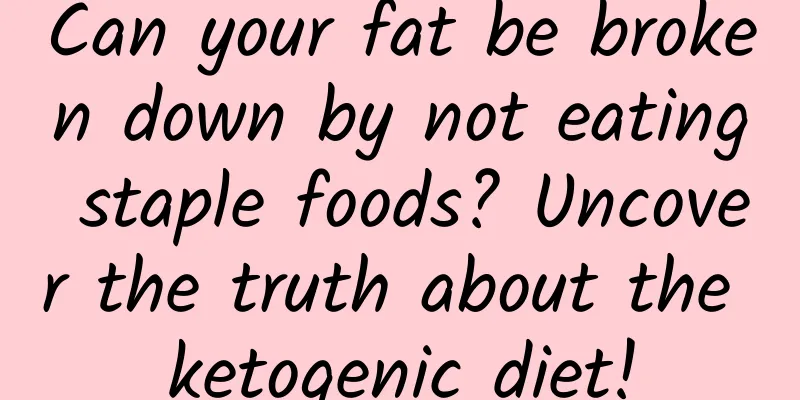Can your fat be broken down by not eating staple foods? Uncover the truth about the ketogenic diet!

|
Losing weight can be said to be a lifelong career for most people. In order to achieve success in this "career", many people keep trying various methods, extreme, mild, easy, difficult... Some of them are indeed effective for a period of time, but after a while, the weight comes back, and sometimes there is even a tendency to surpass the previous weight. For example, the rice-free diet and meat-eating diet, which have been popular in the weight loss industry, have many fans because they are simple to operate and do not require starvation. But is this weight loss method really reliable? This time, Gougou is here to talk to you! Next you will see: 1 The metabolism of the three major energy substances in the human body 2 The truth about the ketogenic diet To know whether a weight loss method is reliable, we must first understand some knowledge about the metabolism of human energy substances. Everyone should know that the human body has three major energy substances: carbohydrates, fats, and proteins. Carbohydrates can be directly converted into proteins and fats, and proteins can also be directly converted into carbohydrates and fats, but fats cannot be directly converted into proteins. Carbohydrates are the main source of energy for the human body. If the human body does not take in enough carbohydrates, it will start to use body fat to provide the energy necessary for life activities; If fat is not enough to provide energy, then protein will be used. However, in general, fat and carbohydrates take on the main task of providing energy. Although protein can also provide energy, it is an important element in the formation of the body and life active substances (various enzymes and antibodies, etc.). And its content is limited. It is the most important health foundation of the body and should not be consumed as energy! Therefore, the three major energy substances have a certain proportion in the body. Carbohydrates account for the largest proportion of total energy, followed by fat, and protein accounts for the least! Let me give you a vivid analogy. Carbohydrates are cash, fat is equivalent to a bankbook, and protein is a house. When we want to buy something, we first use our cash. When we don’t have enough cash, we use our bankbook. When we don’t have enough bankbook, we sell our house. When we adopt extreme dieting to lose weight, we have no cash and not enough bankbook, so we can only dismantle the house to provide energy. When people realized that dieting is too harmful to the body, they began to look for a slightly milder method. If you want to use your bankbook, you can only control the cash on hand. So can controlling carbohydrate intake promote fat decomposition? So the ketogenic diet was born! 1 What is the ketogenic diet? The ketogenic diet (KD) is a diet with a high fat ratio, a low carbohydrate ratio, and appropriate protein and other nutrients. The ketogenic diet is named because the body produces a substance called ketone bodies during the implementation of this diet. We often see diets that do not eat staple foods, diets that only eat fish, diets that only eat eggs, the Atkins diet, the Paleo diet... These diets only require limiting high-carbohydrate foods, such as rice, noodles, potatoes, bread, steamed buns and other staple foods. There is no restriction on the intake of protein and fat, such as meat, nuts, dairy products, fish, eggs, etc., which all have more or less the shadow of "ketogenic diet". 2 The truth about the ketogenic diet When the ketogenic diet first appeared, it was not for weight loss, but for treatment. The ketogenic diet first appeared in the early 1920s. At that time, the development of medicine was limited, and doctors and nutritionists repeatedly encountered patients who were helpless in treating pediatric epilepsy. Against this background, an American doctor named Russel Wilder first proposed to treat patients with a ketogenic diet model, and the clinical effect was quite impressive. Subsequently, this treatment became popular. According to research data, the ketogenic diet can stop 14% of children with epilepsy from having seizures, and reduce the intensity of seizures in about 50% of children with epilepsy. Later, people began to discover that the ketogenic diet can have another use, that is, weight loss. During the ketogenic diet, carbohydrate intake is very low, forcing the body to break down glycogen stored in muscles and liver to supply energy. After about 3 days, glycogen is exhausted, and the body's metabolism is forced to use the "bankbook" and begin to call on adipose tissue for metabolic decomposition. However, during the fat metabolism process, a class of chemicals called ketone bodies are produced. It can also provide energy for important tissues of the body, including muscles, kidneys, etc., so that the body has the strength to function normally. In this way, ketone bodies temporarily replace glucose and take on the responsibility of providing energy. However, these ketone bodies are actually the product of incomplete decomposition of fat. In the case of insufficient carbohydrate intake, it is difficult for fat to be fully decomposed. The conversion of fatty acids into ketone bodies can only release less energy. Therefore, in order to obtain sufficient energy, the human body can only decompose fat in large quantities. This is also the truth that the ketogenic diet can decompose fat in large quantities. However, if the ketone bodies are too high in the body, it will cause poisoning. In order to consume these ketone bodies and prevent them from over-aggregating, the human body has to break down the proteins in the body to react with them, which indirectly speeds up the consumption of protein in the body. Therefore, when adopting a ketogenic diet, carbohydrate intake is insufficient. Even if more fat is consumed, the fat in the body is still broken down quickly. Although more protein is also consumed, the body cannot make full use of it, and the muscles in the body are also slowly broken down and reduced. With multiple approaches, people's weight can naturally be reduced quickly, which naturally attracts a large number of dieters. 3 Three major health risks of the ketogenic diet [1] Ketogenic poisoning Ketone bodies are generated during fat metabolism. Excessive accumulation of ketone bodies in the blood will cause ketotoxicity. Mild symptoms include nausea and vomiting, breath with the smell of rotten apples, headaches, dizziness, drowsiness, etc. Severe symptoms include dehydration, coma, brain hypoxia, and even life-threatening. [2] Malnutrition is caused by insufficient intake of carbohydrate foods and a single diet. The intake of some nutrients other than protein and fat, such as some vitamins, fiber, minerals, etc., is greatly reduced. This will inevitably lead to the risk of an unbalanced diet and micronutrient deficiencies. If this continues for a long time without timely correction, serious health problems will occur, such as constipation and malnutrition. [3] When a ketogenic diet is used to lose weight, carbohydrates, the main source of blood sugar, are greatly reduced in intake, and blood sugar levels also drop accordingly. This can easily lead to "hypoglycemia reactions" such as dizziness, blacking out, cold sweats, fatigue, etc. In severe cases, hypoglycemia can even damage brain cells and cause irreversible brain damage. The ketogenic diet is a double-edged sword, with both advantages and disadvantages. For those who have difficulty losing weight, it may be worth a short-term try under the supervision of a professional. However, after achieving a certain weight loss effect, you should slowly transition back to a healthy and balanced diet. For ordinary people, do not try it lightly without the guidance and supervision of professionals. In particular, it should not be used for a long time without authorization, otherwise it will not only fail to achieve the effect of weight loss, but may even harm your health. Summary: 1 Metabolism of the three major energy substances in the human body Sugar compounds are the main source of energy, fat is a backup force, and protein is generally not used to provide energy. 2 The truth about the ketogenic diet (1) What is the ketogenic diet? The ketogenic diet (ketogenic-diet, referred to as KD) is a formula diet with a high proportion of fat, a low proportion of carbohydrates, and appropriate protein and other nutrients. (2) The truth about the ketogenic diet (3) Three major health risks of the ketogenic diet [1] Causes ketosis [2] Causes malnutrition [3] Causes brain damage References: 1 Bian Dongsheng. Is ketogenic diet reliable for weight loss? [J]. Science Life, 2018(12):41-41. 2 Noakes TD, Windt J. Evidence that supports the prescription of low-carbohydrate high-fat diets: a narrative review. [J]. British Journal of Sports Medicine, 2017, 51(2):133. |
<<: This seasonal rose-colored sea of flowers is actually called Pig
Recommend
“A Bite of China 4” reveals: When food meets physics, it’s amazing!
"A Bite of China" presents Chinese food...
Just look at the restaurants nearby and you will know that the dealers selling home appliances are very happy.
Some time ago, "Midnight Diner" became ...
Aiti Tribe Stories (1): How a rookie transformed into a senior programmer
[51CTO.com original article] Opportunities always...
Are the prescriptions of glasses getting stronger the more you wear them? Don’t ignore these 4 ways to delay the progression of myopia!
Who told you to protect your eyes like this? I wa...
How to open a store through WeChat Mini Program? What are the steps?
When smartphones appeared, few people thought tha...
How virtual reality is reshaping digital advertising
Virtual reality (VR) allows users to experience v...
Most people have paid the "IQ tax" for these 9 products! See how many of them have you been fooled by?
What is IQ tax? Spending a lot of money but not b...
OpenAI: In February 2025, the number of weekly active users of ChatGPT reached 400 million, an increase of 33% from December last year
Despite fierce competition from artificial intell...
Traditional marketing model is dead. How can brand marketing break through and be reborn in the new media era?
1. “The Way of WeChat Operation ” The way of WeCh...
Website login URL submission entry for major search engines
After a website is completed, the next task is to...
Tesla released its Q3 2020 financial report, with net profit reaching US$331 million, a year-on-year increase of 131%
In the past two years, with Tesla's vigorous ...
Does eating baked sweet potatoes often cause cancer? Not really. The sweet potatoes that really shouldn't be eaten are →
Rumor: "Baked sweet potatoes are delicious, ...
Science Time Machine | How did the “Big Bang” come about?
On April 1, 1948 , Gamow proposed the Big Bang th...
Apple responds to the poor battery life of the official version of iOS 15.4, netizens: Upgrading means planning to scrap it
Not long ago, Apple pushed the official version o...
"I grind my teeth in my dreams!" Where does bruxism come from?
(Photo courtesy of TUCHONG Creative) Where is the...









